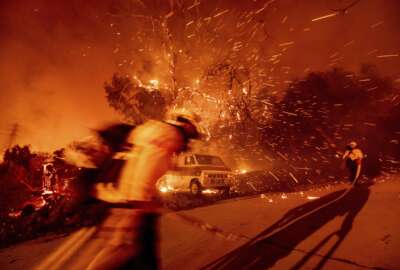
Under infrastructure law, federal firefighters to see increase in pay
Agencies hope to resolve growing recruitment and retention challenges for federal firefighters with a pay raise and new guidance for career paths.
Federal wildland firefighters are set to receive a pay increase that will last for the next two fiscal years.
The temporary raise comes as the departments of Agriculture and Interior and the U.S. Forest Service — agencies that employ federal wildland firefighters — face rising recruitment and retention challenges for the frontline positions.
The salary increase for about 15,000 federal firefighters is funded with $600 million under the Infrastructure Investment and Jobs Act, commonly known as the Bipartisan Infrastructure Law (BIL). Federal firefighters will receive a bump to their biweekly pay starting July 3, up by either $20,000 or 50% of their annual base salary, whichever number is lower.
“Hiring and retaining firefighters in increasingly long and complex fire years is a challenge that we take seriously. The President’s budget and Bipartisan Infrastructure Law provide a significant down payment towards investments in the stable, professional and permanent wildland firefighting workforce we need to confront the wildfire crisis,” USDA Secretary Tom Vilsack said in a June 21 press release.
The temporary pay increase will also incorporate retroactive pay going back to Oct. 1, 2021, the administration wrote in a June 21 fact sheet.
A provision of the BIL initially paused the raise’s enactment, which required USDA, DOI and the Forest Service to analyze and implement the pay increase only in areas where it’s difficult to recruit or retain firefighters. Ultimately, the agencies determined that the raise will apply to “every geographic area,” a June 21 FAQ page stated.
The temporary raise will last through September 2023, and builds on President Joe Biden’s executive order last June, which increased the base pay for all federal firefighters to at least $15 per hour.
Many federal unions and organizations voiced their support for the pay raise. The National Federation of Federal Employees, the union that represents a majority of federal wildland firefighters, said in a June 21 press release that the announcement will go a long way to help agencies hire and keep workers in those positions.
“There has been a serious recruitment and retention problem for wildland firefighters at federal agencies this year. Firefighters simply could not make ends meet on the hopelessly low salaries offered at federal agencies, so jobs were becoming very difficult to fill,” NFFE President Randy Erwin said. “For wildland firefighters, the additional income will give them the opportunity to pay for housing, childcare and other everyday necessities.”
The changes for federal firefighters include more than just a pay raise, though. The BIL funding will also support a mental health program for firefighters.
Additionally, the Office of Personnel Management, in partnership with the Forest Service and DOI, created a new wildland firefighter occupation series —something that has not existed in 50 years. OPM announced on June 21 that the occupation series defined new position descriptions for wildland firefighters.
OPM said the occupation series will support more equitable compensation and a better work-life balance for federal firefighters. In line with other recent efforts from OPM, the job postings will also call on agencies to focus on a skills-based approach when considering applicants. Federal firefighters can opt in to the series, and the new information will let agencies post more specific job opportunities with a clear career progression.
In contrast, the previous approach folded all firefighting jobs into one broad job description, making it difficult for federal wildland firefighters to understand a path for advancement, OPM wrote in a June 21 announcement.
“The new standard is an important step toward recognizing and valuing the wildland firefighter workforce,” OPM wrote. “The clarity on career progression will also support better retention. Wildland firefighters will be able to readily understand the career path and the expectations and requirements for promotions.”
The new occupation series, along with the pay raise, will help long-term efforts to improve federal firefighting positions, said OPM Director Kiran Ahuja.
“These are important steps that will provide a solid foundation for recruitment, retention and further strengthening our wildland firefighter workforce,” Ahuja said in a statement.
“For decades, federal wildland firefighters have faced the challenges of longer, more severe fire years with pay that has lagged behind their counterparts,” the White House wrote. “These measures are a significant step forward that will deliver an immediate, temporary pay raise to federal wildland firefighters across the nation, and sets federal agencies on a path to continue working with stakeholders towards an updated, competitive and equitable pay structure, along with a support system that will address the many challenges that have plagued our wildland firefighter workforce for decades.”
On Capitol Hill, lawmakers are also pushing forward on legislation to help federal firefighters receive better health benefits.
The Federal Firefighter Fairness Act would create the presumption that certain illnesses and disabilities are the result of on-the-job duties for federal firefighters, making them eligible for workers’ compensation.
The Senate Homeland Security and Governmental Affairs committee approved the bill on May 25, following the House’s passage of partnership legislation on May 12 in a vote of 288 to 131. The full Senate has not yet voted on the bill.
Copyright © 2025 Federal News Network. All rights reserved. This website is not intended for users located within the European Economic Area.
Drew Friedman is a workforce, pay and benefits reporter for Federal News Network.
Follow @dfriedmanWFED



